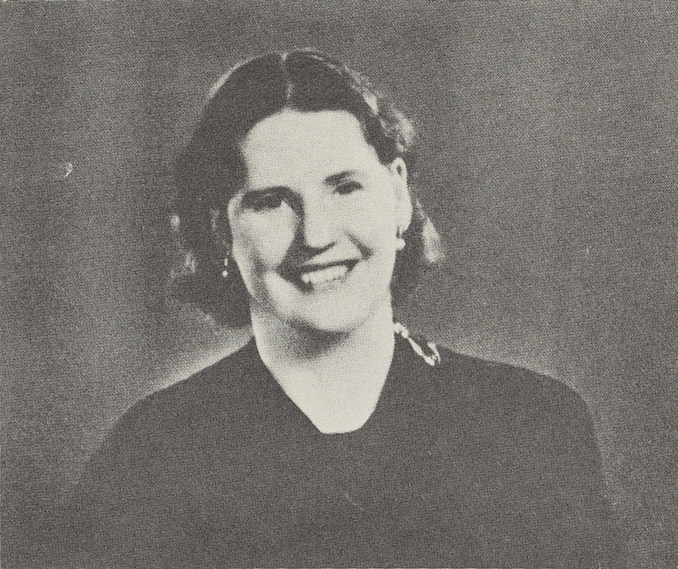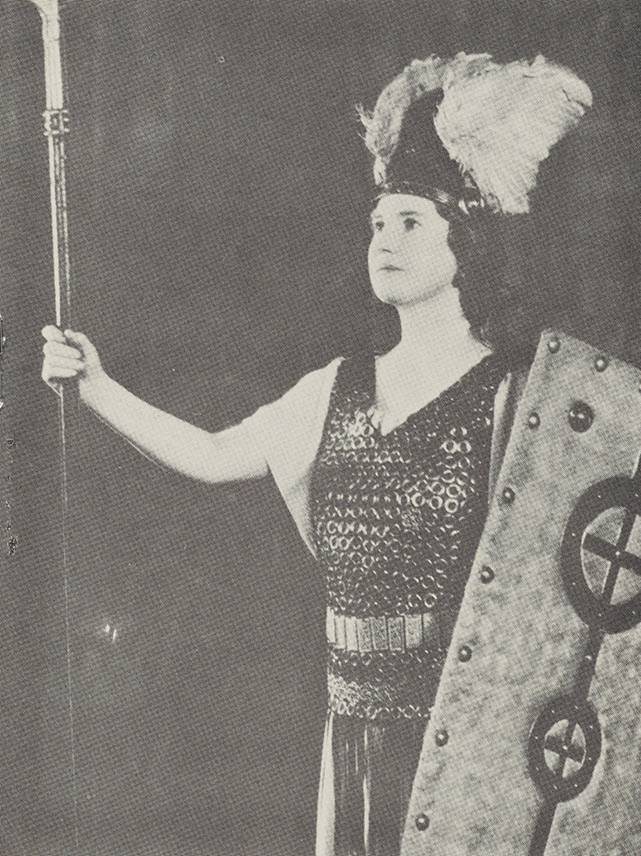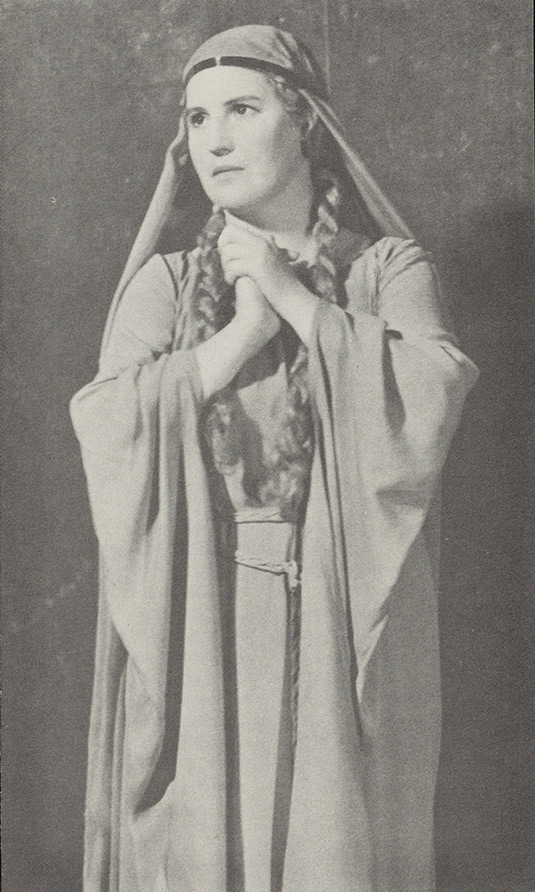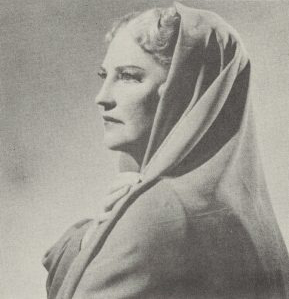A tribute to a soprano sustains opera.
Kirsten Flagstad (1895-1962)
Kirsten Flagstad made her American debut at the Metropolitan Opera House in New York on Feb. 2, 1935. The Norwegian soprano sang the role of Sieglinde in Richard Wagner’s “Die Walküre,” and the sound of her glorious voice was broadcast by radio to a vast audience of opera lovers. Among the listeners, thrilled like everyone else by the new operatic discovery, was a young musician who knew at once that he wanted to be her accompanist. Edwin McArthur was introduced to Kirsten Flagstad informally at a large party shortly before his successful audition. Years later, he described his first impressions in his book “Flagstad: A personal memoir”: “Naturally, I was excited to meet her. But after having heard her at the Metropolitan in striking costumes and in opulent operatic settings, I was not prepared to meet such a strangely unglamorous woman. She was nothing like most other divas I had known. There is no denying, however, that she attracted attention, despite her almost excessive simplicity…. I remember standing aside for a few minutes just looking at her, naturally with admiration for what she was, and praying that my ambition to become her accompanist would be realized, but at the same time, trying to persuade myself that such a woman could really be a Flagstad.”

established the Kirsten Flagstad Memorial in Community Funds, Inc., to be administered for charitable purposes.
The paradoxical woman, Kirsten Flagstad, was born nearly 40 years earlier, on July 12, 1895, in Hamar, Norway. Her parents were of Norwegian farmer stock, but both were professional musicians. After Kirsten’s birth, the family moved to Oslo, where, for the next 18 years, her father conducted and her mother played the piano for a small orchestra. Her mother also coached singers in opera and operetta.
Kirsten’s two brothers and her sister also were talented musicians. The children often played at “opera,” with Kirsten the prima donna, dressed in white dresses and long veils. The children were unfamiliar with Wagner’s music, however, so their elder sister got no practice for her future roles as Brünnhilde and Isolde.
Kirsten’s mother believed music was life’s greatest pleasure, but, at least for a woman, certainly not its most important business. While Kirsten learned to play the piano and sing songs for her own pleasure, she dreamed mainly of being a housewife. As the eldest child in the family, she got a lot of practical experience, for her mother’s work with the orchestra kept her away from home a great deal.
Kirsten’s 10th birthday gift from her parents was the score of “Lohengrin.” It was her introduction to Wagner, and she studied it from beginning to end. Next came “Aïda.” By the time she was 20, Kirsten had mastered 30 operatic roles.
Although she had had some vocal instruction and played the piano occasionally with a dance orchestra to earn extra money, Kirsten had no ambition for a musical career. Earlier, when she was 18, her mother persuaded her to audition for a part at the Oslo National Theater. Kirsten made her debut there on Dec. 12, 1913, in the role of Nuri in Eugen d’Albert’s “Tiefland.” Critics commented that she had “a small voice of nice quality.” Soon after, a benefactor offered her money to study in Sweden.
For the next few years, Kirsten worked hard learning languages and practicing techniques to improve her stage movements. Meanwhile, she studied with a throat specialist who also taught singing, and it was he who began to change Kirsten’s “small voice of nice quality” into a voice of dazzling power and beauty. In March 1918, Kirsten returned to Oslo for her recital debut. It was a great success.
Then Kirsten fell in love. In May 1919 she married Sigurd Hall, a businessman with little interest in music, and settled down happily as a housewife. A year later, she assumed a larger role when her daughter, Else-Marie, was born. For a time, she sang nothing more demanding than lullabies. Her mother, however, could not stand Kirsten’s inactivity, and she lured her back to music with a role at the Opéra Comique in Oslo. For the next few years, Kirsten sang many different roles. At one time, needing money, she agreed to sing show songs at a casino, and at the same time she was singing the soprano solo in a performance of Beethoven’s “Symphony No. 9.” It was a dual assignment that involved frantic costume changes and quick trips from casino to concert hall.

Kirsten’s marriage was not happy. When her husband went to Canada on business in 1928, the couple decided to take out separation papers, leading to divorce. By then, Kirsten was singing regularly, and she was at last able to break away from docile roles and to begin to perform in dramatic parts, such as Aïda and Tosca.
Kirsten was singing in “Lohengrin” in 1929 when she met Henry Johansen, a wealthy industrialist and one of the sponsors of the Oslo opera season. He was a widower with four children. For three days, patron and singer saw each other constantly, but they were still not on a first-name basis when Johansen took her hand and said, “Well, Madame Flagstad, you love me, don’t you?” She did. They were married on May 31, 1930, when her divorce from Hall had become final.
Kirsten often claimed she wanted nothing more than to play housewife again, but the fact is, she soon accepted an invitation to sing the glorious but demanding role of Isolde in Wagner’s “Tristan and Isolde” —an hour and a half of actual singing. She went on to sing that role in 182 performances in her career. In 1932, with Henry’s encouragement, Kirsten went to Bayreuth, Germany, and began singing minor roles with a company there to steep herself in the Wagnerian tradition. By her second season in Bayreuth, she was confident of her growing voice as well as her growing maturity as a Wagnerian singer.
Soon after, the Metropolitan Opera Association invited her to sing during its coming season. Kirsten finished up her contract with a company in Gothenburg, Sweden, studying her Metropolitan roles between performances. Then, on Feb. 2, 1935, she made her memorable American debut. The critics were unanimous in their praise. Four days later, as Isolde, Kirsten confirmed their first enthusiastic impression. Here, indeed, was a new star of the first magnitude.
For the next five years, that star blazed. With Edwin McArthur as her accompanist (aside from his fine musicianship, she approved of Edwin because he was tall and “didn’t make me look like a giantess”), Kirsten toured throughout America and sang for radio broadcasts. At home again in Norway, she received her first decoration from the king. If she reveled in the adulation heaped upon her by an adoring public, she also resented the demands the public made on her privacy. In his book, “The Flagstad Manuscript,” Louis Biancolli describes Kirsten’s encounter with another celebrity: “Not long ago, I rode up on the elevator of my hotel,” Kirsten said. “Charlie Chaplin entered it on one floor. As much as I wanted to look at him, I turned my back. I respected his privacy. That’s the way I’d like to be treated.” Despite such protests, Kirsten’s friends were more inclined to believe she thoroughly enjoyed every bit of attention.
Kirsten Flagstad was a great artist, a complex person who protested that she was simple, and she had her share of idiosyncrasies. She disliked social events and backstage visitors. Though she traveled widely, she never went sightseeing, preferring to spend her free time playing solitaire. She justified her remoteness because of the huge demands singing made on her, and she never stinted on that. Musically, her approach was flawless, although she was sometimes criticized for an “unintellectual approach” to her roles. She worked hard, always gave her best—which was magnificent —and never broke a contract. In return, she felt she had a right to be left alone to play solitaire.
Many artists have certain preperformance rituals; Kirsten Flagstad was no exception. Before she left her hotel for a concert, Edwin always played for her Jerome Kern’s “Lovely to Look At.” Then, before she stepped on stage, either Edwin or her husband would blow cigar smoke in her face. But she detested cigarettes and would not allow them to be smoked in her presence. Kirsten had surprisingly few fears about the condition of her throat or her general health. In winter, she carelessly went about with her coat open, never wore scarves, and refused to coddle herself.
Opera singing was an exhausting profession, and Kirsten often talked of giving it up altogether. Feeling that she had accomplished a great deal in a very short time, she arranged to return to Norway with her daughter, Else, in the spring of 1940. But while she was on tour with the Metropolitan cast, her close friend and favorite tenor, Lauritz Melchior, broke the news Germany had invaded Norway. Then came a cable from Henry in Norway: STAY WHERE YOU ARE. I AM ALL RIGHT. Kirsten and Else cancelled their plans to sail to Europe and instead took a train west. A few months later, Else married a young American, Arthur Dusenberry. Flagstad, receiving conflicting advice from all around her—including former President Herbert Hoover and Henry’s daughter, Annie, who had recently arrived from Norway—debated whether to try to get back to Norway and her husband or to wait out the war in the United States.

Her mind made up at last, Flagstad made a final appearance as Isolde in April 1941, at the Metropolitan and flew to Norway. After a 19-month separation, she and Henry were reunited and settled down to whatever life they could have in their occupied country. Flagstad did some singing in neutral Sweden and Switzerland; Henry, who had been a pre-war member of the conservative Nasjonal Samling, Vidkun Quisling’s party, resigned from the pro-Nazi group in the summer of 1941 and attended to business affairs.
The end of the war brought trouble. On May 13, 1945, while Kirsten and Henry were strolling in their garden, armed men appeared and took Henry to a detention camp, where he was held because of his former political affiliation. She never saw him again. “I believe a new Kirsten Flagstad was born that day,” she said later. “I’m afraid that whatever softness was in me vanished forever.”
Kirsten and her husband were allowed to communicate by postcard once a month. In one of these exchanges Henry advised his wife to resume her career. But before she could begin singing abroad again, he became quite ill, and Kirsten knew she could not leave. He died in June 1946. Flagstad was not permitted to leave Norway until her family finances had been disentangled by the government, but in 1947 she was able to go to Switzerland. That spring, she sailed for America to visit her daughter and her new grandson. And, naturally, she began to sing again.
Pickets greeted Flagstad’s return to the concert stage. The war in Europe was over, but the war over Flagstad went on: She had of her own free will returned to German-occupied Norway. Many applauded her as a patriotic Norwegian and devoted wife who sought only to be with her husband in time of trouble. Though her friends steadfastly maintained that she never sang in Germany or in her German-occupied homeland during this period, some detractors refused to believe it. Pickets demonstrated and disturbances interrupted her concerts, but Flagstad continued to sing in the United States, in South America, and in Europe. Tribulation seemed to strengthen her. Still, there had been no invitation from the Metropolitan, and Flagstad returned to Norway to study and rest. She was 53 and had been singing for a quarter of a century.
Then Rudolf Bing took over as manager of the Metropolitan Opera. He contacted Kirsten, and on Jan. 22, 1951, Flagstad sang Isolde at the Met once more, almost 10 years after her last Isolde performance before she left for Norway. It was a joyous return, with 19 curtain calls. She had made up her mind that that single season also would be her only season, and with her “final” Isolde on March 26, 1951, the audience gave her a 22-minute ovation. But Bing persuaded her to come back for one more season to sing not Wagner, but Christoph Gluck’s “Alceste.” She gave five performances, the last on April 1, 1952. And that was, indeed, Kirsten Flagstad’s last opera performance in America.
Kristen Flagstad had decided that her final public appearance would take place on Dec. 12, 1953, at the National Theater of Oslo, at the same place and on the same date her career had begun 40 years earlier. Old accusations still flared occasionally, but her formal farewell was a total triumph. In the years that followed, Kristen Flagstad enjoyed an active retirement. She was in constant demand as a recording artist. And she was appointed director of the Norwegian State Opera, which opened its first season under her direction with “Tiefland,” in which the young Kirsten had made her debut.
But Kirsten had been ailing for some time, and her condition gradually grew worse. She died quietly on Dec. 7, 1962, at age 67. Fortunately, much of her greatest work had been recorded, and opera lovers for generations to come will thrill to the breadth, power, and brilliance of her magnificent voice.
A short time after her death, members of the Metropolitan Opera Guild, an independent group of opera lovers and supporters of the Metropolitan Opera, met to discuss a way to honor her memory. In 1964, the Kirsten Flagstad Memorial Fund was established at The New York Community Trust. Devoted friends of Kirsten Flagstad supported the fund which is used for awards, and other forms of assistance, to vocalists, instrumentalists, teachers, coaches or others in the field of musical, and especially operatic, composition or production. With preference to those focusing on Wagnerian repertoire.
The prima donna understood well that many artists’ talents are woven into the glittering tapestry of the opera.
